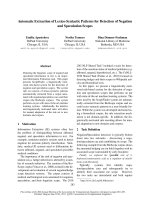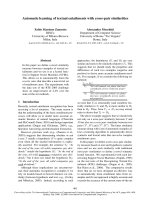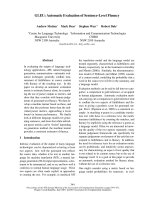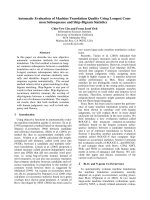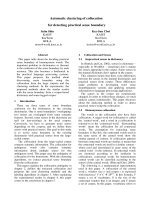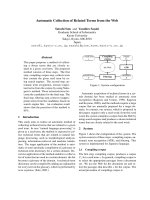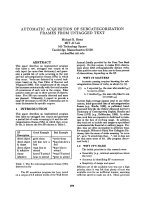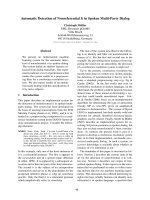Báo cáo khoa học: "Automatic Identification of Non-compositional Phrases" pdf
Bạn đang xem bản rút gọn của tài liệu. Xem và tải ngay bản đầy đủ của tài liệu tại đây (673.24 KB, 8 trang )
Automatic Identification of Non-compositional Phrases
Dekang Lin
Department of Computer Science
University of Manitoba
and
Winnipeg, Manitoba, Canada, R3T 2N2
UMIACS
University of Maryland
College Park, Maryland, 20742
Abstract
Non-compositional expressions present a special
challenge to NLP applications. We present a method
for automatic identification of non-compositional ex-
pressions using their statistical properties in a text
corpus. Our method is based on the hypothesis that
when a phrase is non-composition, its mutual infor-
mation differs significantly from the mutual infor-
mations of phrases obtained by substituting one of
the word in the phrase with a similar word.
1 Introduction
Non-compositional expressions present a special
challenge to NLP applications. In machine transla-
tion, word-for-word translation of non-compositional
expressions can result in very misleading (sometimes
laughable) translations. In information retrieval, ex-
pansion of words in a non-compositional expression
can lead to dramatic decrease in precision without
any gain in recall. Less obviously, non-compositional
expressions need to be treated differently than other
phrases in many statistical or corpus-based NLP
methods. For example, an underlying assumption in
some word sense disambiguation systems, e.g., (Da-
gan and Itai, 1994; Li et al., 1995; Lin, 1997), is that
if two words occurred in the same context, they are
probably similar. Suppose we want to determine the
intended meaning of "product" in "hot product".
We can find other words that are also modified by
"hot" (e.g., "hot car") and then choose the mean-
ing of "product" that is most similar to meanings
of these words. However, this method fails when
non-compositional expressions are involved. For in-
stance, using the same algorithm to determine the
meaning of "line" in "hot line", the words "product",
"merchandise", "car",
etc.,
would lead the algorithm
to choose the "line of product" sense of "line".
We present a method for automatic identification
of non-compositional expressions using their statis-
tical properties in a text corpus. The intuitive idea
behind the method is that the metaphorical usage
of a non-compositional expression causes it to have
a different distributional characteristic than expres-
sions that are similar to its literal meaning.
2 Input Data
The input to our algorithm is a collocation database
and a thesaurus. We briefly describe the process of
obtaining this input. More details about the con-
struction of the collocation database and the the-
saurus can be found in (Lin, 1998).
We parsed a 125-million word newspaper corpus
with Minipar, 1 a descendent of Principar (Lin, 1993;
Lin, 1994), and extracted dependency relationships
from the parsed corpus. A dependency relationship
is a triple:
(head type
modifier), where head and
modifier are words in the input sentence and
type
is the type of the dependency relation. For example,
(la) is an example dependency tree and the set of
dependency triples extracted from (la) are shown in
(lb).
compl
John married Peter's sister
b. (marry V:subj:N John), (marry
V:compl:N sister), (sister N:gen:N Peter)
There are about 80 million dependency relation-
ships in the parsed corpus. The frequency counts of
dependency relationships are filtered with the log-
likelihood ratio (Dunning, 1993). We call a depen-
dency relationship a collocation if its log-likelihood
ratio is greater than a threshold (0.5). The number
of unique collocations in the resulting database 2 is
about 11 million.
Using the similarity measure proposed in (Lin,
1998), we constructed a corpus-based thesaurus 3
consisting of 11839 nouns, 3639 verbs and 5658 ad-
jective/adverbs which occurred in the corpus at least
100 times.
3 Mutual Information of a
Collocation
We define the probability space to consist of all pos-
sible collocation triples. We use LH R M L to denote the
1
available at
2available at
nitob&.ca/-lindek/nlldemo.htm/
3available at
317
frequency count of all the collocations that match
the pattern (H R M), where H and M are either words
or the wild card (*) and R is either a dependency
type or the wild card. For example,
• [marry V:¢ompl:N
sister[
is the frequency count of
(marry V: compl :N sister).
• [marry V:compl:~ *1 is the total frequency count of
collocations in which the head is marry and the
type is V:compl:hi (the verb-object relation).
• I* * *l is the total frequency count of all collo-
cations extracted from the corpus.
To compute the mutual information in a colloca-
tion, we treat a collocation (head type modifier)
as the conjunction of three events:
A: (* type *)
B: (head * *)
C: (* * modifier)
The mutual information of a collocation is the log-
arithm of the ratio between the probability of the
collocation and the probability of events A, B, and
C co-occur if we assume B and C are conditionally
independent given A:
(2)
mutualInfo(head, type, modifier)
P(A,B,c)
= log
P(B[A)P(C[A)P(A)
[head type
modifier[
* * *]
= log( [,
type
*[ [head type *[ [*
t~Te
modifier[ )
[*
* *[ [* type *1 [*type
*1
• , ]head type modifier[x * type *
log,]head
type
* x * type modifier /
4 Mutual Information and Similar
Collocations
In this section, we use several examples to demon-
strate the basic idea behind our algorithm.
Consider the expression "spill gut". Using the au-
tomatically constructed thesaurus, we find the fol-
lowing top-10 most similar words to the verb "spill"
and the noun "gut":
spill: leak 0.153, pour 0.127, spew 0.125, dump
0.118, pump 0.098, seep 0.096, burn 0.095, ex-
plode 0.094, burst 0.092, spray 0.091;
gut: intestine 0.091, instinct 0.089, foresight 0.085,
creativity 0.082, heart 0.079, imagination 0.076,
stamina 0.074, soul 0.073, liking 0.073, charisma
0.071;
The collocation "spill gut" occurred 13 times in the
125-million-word corpus. The mutual information
of this collocation is 6.24. Searching the collocation
database, we find that it does not contain any collo-
cation in the form
(simvspilt
V:compl:hl gut) nor
(spill V: compl :N
simngut),
where
sirnvsp~u
is a
verb similar to "spill" and
simng,,~
is a noun sim-
ilar to "gut". This means that the phrases, such
as "leak gut", "pour gut", or "spill intestine",
"spill instinct", either did not appear in the corpus
at all, or did not occur frequent enough to pass the
log-likelihood ratio test.
The second example is "red tape". The top-10
most similar words to "red" and "tape" in our the-
saurus are:
red:
yellow 0.164, purple 0.149, pink 0.146, green
0.136, blue 0.125, white 0.122, color 0.118, or-
ange 0.111, brown 0.101, shade 0.094;
tape:
videotape 0.196, cassette 0.177, videocassette
0.168, video 0.151, disk 0.129, recording 0.117,
disc 0.113, footage 0.111, recorder 0.106, audio
0.106;
The following table shows the frequency and mutual
information of "red tape" and word combinations
in which one of "red" or "tape" is substituted by a
similar word:
Table 1: red tape
mutual
verb object freq info
red tape 259 5.87
yellow tape 12 3.75
orange tape 2 2.64
black tape 9 1.07
Even though many other similar combinations ex-
ist in the collocation database, they have very differ-
ent frequency counts and mutual information values
than "red tape".
Finally, consider a compositional phrase: "eco-
nomic impact". The top-10 most similar words are:
economic:
financial 0.305, political 0.243, social
0.219, fiscal 0.209, cultural 0.202, budgetary
0.2, technological 0.196, organizational 0.19,
ecological 0.189, monetary 0.189;
impact:
effect 0.227, implication 0.163, conse-
quence 0.156, significance 0.146, repercussion
0.141, fallout 0.141, potential 0.137, ramifica-
tion 0.129, risk 0.126, influence 0.125;
The frequency counts and mutual information val-
ues of "economic impact" and phrases obtained by
replacing one of "economic" and "impact" with a
similar word are in Table 4. Not only many combi-
nations are found in the corpus, many of them have
very similar mutual information values to that of
318
Table 2: economic impact
verb
economic
financial
political
social
budgetary
ecological
economic
economic
economic
economic
economic
economic
economic
economic
economic
object
impact
impact
impact
impact
impact
impact
effect
implication
consequence
significance
fallout
repercussion
potential
ramification
risk
mutual
freq info
171 1.85
127 1.72
46 0.50
15 0.94
8 3.20
4 2.59
84 0.70
17 0.80
59 1.88
10 0.84
7 1.66
7 1.84
27 1.24
8 2.19
17 -0.33
nomial distribution can be accurately approximated
by a normal distribution (Dunning, 1993). Since
all the potential non-compositional expressions that
we are considering have reasonably large frequency
counts, we assume their distributions are normal.
Let
Ihead 1;ype
modifier I
= k and 1. * .1 = n. The
maximum likelihood estimation of the true proba-
bility p of the collocation (head type modifier) is
/5 = ~. Even though we do not know what p is, since
p is (assumed to be) normally distributed, there is
N% chance that it falls within the interval
k_.4_ZN _ k.4_z N n ,~,
n
V
n n n n
where
ZN
is a constant related to the confidence level
N and the last step in the above derivation is due to
the fact that k is very small. Table 3 shows the z~
values for a sample set of confidence intervals.
"economic impact". In fact, the difference of mu-
tual information values appear to be more impor-
tant to the phrasal similarity than the similarity of
individual words. For example, the phrases "eco-
nomic fallout" and "economic repercussion" are in-
tuitively more similar to "economic impact" than
"economic implication" or "economic significance",
even though "implication" and "significance" have
higher similarity values to "impact" than "fallout"
and "repercussion" do.
These examples suggest that one possible
way to separate compositional phrases and non-
compositional ones is to check the existence and mu-
tual information values of phrases obtained by sub-
stituting one of the words with a similar word. A
phrase is probably non-compositional if such sub-
stitutions are not found in the collocation database
or their mutual information values are significantly
different from that of the phrase.
5 Algorithm
In order to implement the idea of separating non-
compositional phrases from compositional ones with
mutual information, we must use a criterion to de-
termine whether or not the mutual information val-
ues of two collocations are significantly different. Al-
though one could simply use a predetermined thresh-
old for this purpose, the threshold value will be to-
tally arbitrary, b-hrthermore, such a threshold does
not take into account the fact that with different fre-
quency counts, we have different levels confidence in
the mutual information values.
We propose a more principled approach. The fre-
quency count of a collocation is a random variable
with binomial distribution. When the frequency
count is reasonably large (e.g., greater than 5), a bi-
Table 3: Sample
ZN
values
IN% 150% 80% 90% 95% 98% 99% I
zg
0.67 1.28 1.64 1.96 2.33 2.58
We further assume that the estimations of
P(A),
P(B]A)
and
P(CIA )
in (2) are accurate. The confi-
dence interval for the true probability gives rise to a
confidence interval for the true mutual information
(mutual information computed using the true proba-
bilities instead of estimations). The upper and lower
bounds of this interval are obtained by substituting
k with
k+z~v'-g
and k-z~vff in (2). Since our con-
n n n
fidence of p falling between k+,~v~ is N%, we can
I%
have N% confidence that the true mutual informa-
tion is within the upper and lower bound.
We use the following condition to determine
whether or not a collocation is compositional:
(3) A collocation a is non-compositional if there
does not exist another collocation/3 such that
(a) j3 is obtained by substituting the head or
the modifier in a with a similar word and (b)
there is an overlap between the 95% confidence
interval of the mutual information values of a
and f~.
For example, the following table shows the fre-
quency count, mutual information (computed with
the most likelihood estimation) and the lower and
upper bounds of the 95% confidence interval of the
true mutual information:
freq. mutual lower upper
verb-object count info bound bound
make difference 1489 2.928 2.876 2.978
make change 1779 2.194 2.146 2.239
319
Since the intervals are disjoint, the two colloca-
tions are considered to have significantly different
mutual information values.
6 Evaluation
There is not yet a well-established methodology
for evaluating automatically acquired lexical knowl-
edge. One possibility is to compare the automati-
cally identified relationships with relationships listed
in a manually compiled dictionary. For example,
(Lin, 1998) compared automatically created the-
saurus with the WordNet (Miller et al., 1990) and
Roget's Thesaurus. However, since the lexicon used
in our parser is based on the WordNet, the phrasal
words in WordNet are treated as a single word.
For example, "take advantage of" is treated as a
transitive verb by the parser. As a result, the
extracted non-compositional phrases do not usu-
ally overlap with phrasal entries in the WordNet.
Therefore, we conducted the evaluation by manu-
ally examining sample results. This method was
also used to evaluate automatically identified hy-
ponyms (Hearst, 1998), word similarity (Richardson,
1997), and translations of collocations (Smadja et
al., 1996).
Our evaluation sample consists of 5 most frequent
open class words in the our parsed corpus: {have,
company, make, do, take} and 5 words whose fre-
quencies are ranked from 2000 to 2004: {path, lock,
resort, column, gulf}. We examined three types of
dependency relationships: object-verb, noun-noun,
and adjective-noun. A total of 216 collocations were
extracted, shown in Appendix A.
We compared the collocations in Appendix A with
the entries for the above 10 words in the NTC's
English Idioms Dictionary (henceforth NTC-EID)
(Spears and Kirkpatrick, 1993), which contains ap-
proximately 6000 definitions of idioms. For our eval-
uation purposes, we selected the idioms in NTC-EID
that satisfy both of the following two conditions:
(4) a. the head word of the idiom is one of the
above 10 words.
b. there is a verb-object, noun-noun, or
adjective-noun relationship in the idiom
and the modifier in the phrase is not a
variable. For example, "take a stab at
something" is included in the evaluation,
whereas "take something at face value" is
not.
There are 249 such idioms in NTC-EID, 34 of which
are also found in Appendix A (they are marked with
the '+' sign in Appendix A). If we treat the 249 en-
tries in NTC-EID as the gold standard, the precision
and recall of the phrases in Appendix A are shown in
Table 4, To compare the performance with manually
compiled dictionaries, we also compute the precision
and recall of the entries in the Longman Dictionary
of English Idioms (LDOEI) (Long and Summers,
1979) that satisfy the two conditions in (4). It can
be seen that the overlap between manually compiled
dictionaries are quite low, reflecting the fact that dif-
ferent lexicographers may have quite different opin-
ion about which phrases are non-compositional.
Precision Recall Parser Errors
Appendix A 15.7% 13.7% 9.7%
LDOEI 39.4% 20.9% N.A.
Table 4: Evaluation Results
The collocations in Appendix A are classified into
three categories. The ones marked with '+' sign
are found in NTC-EID. The ones marked with 'x'
are parsing errors (we retrieved from the parsed cor-
pus all the sentences that contain the collocations in
Appendix A and determine which collocations are
parser errors). The unmarked collocations satisfy
the condition (3) but are not found in NTC-EID.
Many of the unmarked collocation are clearly id-
ioms, such as "take (the) Fifth Amendment" and
"take (its) toll", suggesting that even the most com-
prehensive dictionaries may have many gaps in their
coverage. The method proposed in this paper can
be used to improve the coverage manually created
lexical resources.
Most of the parser errors are due to the incom-
pleteness of the lexicon used by the parser. For ex-
ample, "opt" is not listed in the lexicon as a verb.
The lexical analyzer guessed it as a noun, causing
the erroneous collocation "(to) do opt". The col-
location "trig lock" should be "trigger lock". The
lexical analyzer in the parser analyzed "trigger" as
the -er form of the adjective "trig" (meaning well-
groomed).
Duplications in the corpus can amplify the effect
of a single mistake. For example, the following dis-
claimer occurred 212 times in the corpus.
"Annualized average rate of return after ex-
penses for the past 30 days: not a forecast
of future returns"
The parser analyzed '% forecast of future returns"
as [S [NP a forecast of future] [VP returns]]. As a
result, (return V:subj :N forecast) satisfied the
condition (3).
Duplications can also skew the mutual informa-
tion of correct dependency relationships. For ex-
ample, the verb-object relationship between "take"
and "bride" passed the mutual information filter be-
cause there are 4 copies of the article containing this
phrase. If we were able to throw away the duplicates
and record only one count of "take-bride", it would
have not pass the mutual information filter (3).
320
The fact that systematic parser errors tend to
pass the mutual information filter is both a curse
and a blessing. On the negative side, there is
no obvious way to separate the parser errors from
true non-compositional expressions. On the positive
side, the output of the mutual information filter has
much higher concentration of parser errors than the
database that contains millions of collocations. By
manually sifting through the output, one can con-
struct a list of frequent parser errors, which can then
be incorporated into the parser so that it can avoid
making these mistakes in the future. Manually go-
ing through the output is not unreasonable, because
each non-compositional expression has to be individ-
ually dealt with in a lexicon anyway.
To find out the benefit of using the dependency
relationships identified by a parser instead of simple
co-occurrence relationships between words, we also
created a database of the co-occurrence relationship
between part-of-speech tagged words. We aggre-
gated all word pairs that occurred within a 4-word
window of each other. The same algorithm and simi-
larity measure for the dependency database are used
to construct a thesaurus using the co-occurrence
database. Appendix B shows all the word pairs that
satisfies the condition (3) and that involve one of
the 10 words {have, company, make, do, take, path,
lock, resort, column, gulf}. It is clear that Appendix
B contains far fewer true non-compositional phrases
than Appendix A.
7 Related Work
There have been numerous previous research on ex-
tracting collocations from corpus, e.g., (Choueka,
1988) and (Smadja, 1993). They do not, however,
make a distinction between compositional and non-
compositional collocations. Mutual information has
often been used to separate systematic associations
from accidental ones. It was also used to compute
the distributional similarity between words CHin -
dle, 1990; Lin, 1998). A method to determine the
compositionality of verb-object pairs is proposed in
(Tapanainen et al., 1998). The basic idea in there
is that "if an object appears only with one verb (of
few verbs) in a large corpus we expect that it has an
idiomatic nature" (Tapanainen et al., 1998, p.1290).
For each object noun o, (Tapanainen et al., 1998)
computes the distributed frequency
DF(o)
and rank
the non-compositionality of o according to this value.
Using the notation introduced in Section 3,
DF(o)
is computed as follows:
DF(o) = ~ Iv,,
v:compl:~, ol a
n b
i=1
where
{vl,v2,
,vn} are verbs in the corpus that
took o as the object and where a and b are constants.
The first column in Table 5 lists the top 40 verb-
object pairs in (Tapanainen et ai., 1998). The "mi"
column show the result of our mutual information
filter. The '+' sign means that the verb-object pair
is also consider to be non-compositional according
to mutual information filter (3). The '-' sign means
that the verb-object pair is present in our depen-
dency database, but it does not satisfy condition (3).
For each '-' marked pairs, the "similar collocation"
column provides a similar collocation with a similar
mutual information value (i.e., the reason why the
pair is not consider to be non-compositional). The
'<>' marked pairs are not found in our collocation
database for various reasons. For example, "finish
seventh" is not found because "seventh" is normal-
ized as "_NUM", "have a go" is not found because
"a
go" is not an entry in our lexicon, and "take ad-
vantage" is not found because "take advantage of"
is treated as a single lexical item by our parser. The
~/marks in the "ntc" column in Table 5 indicate
that the corresponding verb-object pairs is an idiom
in (Spears and Kirkpatrick, 1993). It can be seen
that none of the verb-object pairs in Table 5 that
are filtered out by condition (3) is listed as an idiom
in NTC-EID.
8 Conclusion
We have presented a method to identify non-
compositional phrases. The method is based on the
assumption that non-compositionai phrases have a
significantly different mutual information value than
the phrases that are similar to their literal mean-
ings. Our experiment shows that this hypothesis is
generally true. However, many collocations resulted
from systematic parser errors also tend to posses this
property.
Acknowledgements
The author wishes to thank ACL reviewers for
their helpful comments and suggestions. This re-
search was partly supported by Natural Sciences
and Engineering Research Council of Canada grant
OGP121338.
References
Y. Choueka. 1988. Looking for needles in a haystack or lo-
cating interesting collocational expressions in large tex-
tual databases. In
Proceedings of the RIA O Conference on
User-Oriented Content-Based Text and Image Handling,
Cambridge, MA, March 21-24.
Ido Dagan and Alon Itai. 1994. Word sense disambiguation
using a second language monolingual corpus.
Computa-
tional Linguistics,
20(4):563-596.
Ted Dunning. 1993. Accurate methods for the statistics
of surprise and coincidence.
Computational Linguistics,
19(1):61-74, March.
Marti A. Hearst. 1998. Automated discovery of wordnet re-
lations. In C. Fellbaum, editor,
WordNet: An Electronic
Lezical Database,
pages 131-151. MIT Press.
321
Table 5: Comparison with
(Tapanainen et al., 1998)
verb-object mi ntc similar collocation
take toll +
go bust +
make plain +
mark anniversary - celebrate anniversary
finish seventh o
make inroad - make headway
do homework - do typing
have hesitation - have misgiving
give birth + ~/
have a=go
O X/
make mistake - make miscalculation
go so=far=as o
take precaution +
look as=though o
commit suicide - commit crime
pay tribute - pay homage
take place + ~/
make mockery +
make headway - make inroad
take wicket
o
cost $ - cost million
have qualm - have misgiving
make pilgrimage - make foray
take
advantage o ~/
make debut +
have second=thought
o ~/
do job - do work
finish sixth o
suffer heartattack
o
decide whether o
have impact - have effect
have chance - have opportunity
give warn
o
have sexual=intercourse - have sex
take plunge +
have misfortune - share misfortune
thank
goodness
+
have
nothing o
make money - make profit
strike chord + ~/
Donald Hindle. 1990. Noun classification from predicate-
argument structures. In
Proceedings of ACL-90,
pages
268-275, Pittsburg, Pennsylvania, June.
Xiaobin Li, Stan Szpakowicz, and Stan Matwin. 1995. A
WordNet-based algorithm for word sense disambiguation.
In
Proceedings of IJCAI-95,
pages 1368-1374, Montreal,
Canada, August.
Dekang Lin. 1993. Principle-based parsing without overgen-
eration. In
Proceedings of ACL-93,
pages 112-120, Colum-
bus, Ohio.
Dekang Lin. 1994. Principar an efficient, broad-coverage,
principle-based parser. In
Proceedings of COLING-9$,
pages 482-488. Kyoto, Japan.
Dekang Lin. 1997. Using syntactic dependency as local con-
text to resolve word sense ambiguity. In
Proceedings of
ACL/EACL-97,
pages 64-71, Madrid, Spain, July.
Dekang Lin. 1998. Automatic retrieval and clustering of simi-
lar words. In
Proceedings of COLING/ACL-98,
pages 768-
774, Montreal.
T. H. Long and D. Summers, editors. 1979.
Longman Die-
tionary of English Idioms.
Longman Group Ltd.
George A. Miller, Richard Beckwith, Christiane Fellbaum,
Derek Gross, and Katherine J. Miller. 1990. Introduction
to WordNet: An on-line lexical database.
International
Journal of Lexicography,
3(4):235-244.
Stephen D. Richardson. 1997.
Determining Similarity and
Inferring Relations in a Lexical Knowledge Base.
Ph.D.
thesis, The City University of New York.
Frank Smadja, Kathleen R. McKeown, and Vasileios Hatzi-
vassiloglou. 1996. Translating collcations for bilingual lex-
icons: A statistical approach.
Computational Linguistics,
22(1):1-38, March.
Frank Smadja. 1993. Retrieving collocations from text:
Xtract.
Computational Linguistics,
19(1):143-178.
R. A. Spears and B. Kirkpatrick. 1993.
NTC's English Id-
ioms Dictionary.
National Textbook Company.
Pasi Tapanainen, Jussi Piitulainen, and Timo J~vinen. 1998.
Idiomatic object usage and support verbs. In
Proceedings
of COLING/ACL-98,
pages 1289-1293, Montreal, Canada.
Appendix
A
Among the collocations in which the head word is
one of {have, company, make, do, take, path, lock,
resort, column, gulf}, the 216 collocations in the fol-
lowing table are considered by our program to be
idioms (i.e., they satisfy condition (3)). The codes
in the remark column are explained as follows:
×: parser errors;
+: collocations found in NTC-EID.
collocation remark
(to) have (the) decency
(to) have (all the) earmark(s)
(to) have enough +
(to) have
falling +
have figuring x
have giving x
(to) have (a) lien (against)
(to) have (all the) making(s) (of)
(to) have plenty
(to) have (a) record
have working x
have
wrought ×
(a) holding company
(a) touring company
(a) insurance company
Sinhalese make x
mistake make x
mos make x
(to) make abrasive
(to) make acquaintance
(to) make believer (out of)
(to) make bow
(to) make (a) case
(to) make (a) catch
(to) make (a) dash
(to) make (one's) debut
(to) make (up) (the) bow Jones Indus-
trial Average
(to) make (a) duplicate
(to) make enemy
(to) make (an) error
(to) make (an) exception +
(to) make (an) excuse
(to) make (a) fool +
(to) make (a) fortune
(to) make friend +
322
collocation remark
(to) make (a) fuss +
(tO) make (a) grab
(to) make grade
+
(tO) make (a) guess
(to) make hay +
(to) make headline(s)
(to) make (a) killing +
(to) make (a) living +
(to) make (a) long-distance call
(to) make (one's) mark
(to) make (no) mention
(to) make (one's) mind (up) +
(to) make (a) mint
(to) make (a) mockery (of)
(to) make noise
(to) make (a) pitch +
(to) make plain ×
(to) make (a) point +
(to) make preparation(s)
(to) make (no) pretense
(to) make (a) pun
(to) make referral(s)
(to) make (the) round(s)
(to) make (a) run (at) +
(to) make savings and loan association x
(to) make (no) secret
(to) make (up) sect
(to) make sense ~ +
(to) make (a) shamble(s) (of)
(to) make (a) showing
(to) make (a) splash
(to) make (a) start
(to) make (a) stop
(to) make (a) tackle
(to) make (a) turn
(to) make (a) virtue (of)
(to) make wonder ×
(to) do (an) about-face +
(to) do at home ×
(to) do bargain-hunting
(to) do both
(to) do business
(to) do (a) cameo
(to) do casting
(to) do damage
(to) do deal(s)
(to) do (the) deed
(to) do (a) disservice
(to) do either
(to) do enough
(to) do (a) favor
(to) do honor(s)
+
(to) do I. ×
(to)
do
(an) imitation
(to) do justice +
(to) do OK
(to) do opt ×
(to) do puzzle
do Santos x
(to) do stunt(s)
(to) do (the) talking
collocation
(to) do (the) trick
(to) do (one's) utmost (to)
(to) do well
(to) do wonder(s)
(tO) do (much) worse
do you
(the) box-office take
(to) take aim
(to) take back
(to) take (the) bait
(to) take (a) beating
(tO) take (a) bet
(to) take (a) bite
(to) take (a) bow
(to) take (someone's) breath (away)
(to) take (the) bride (on honeymoon)
(to) take charge
(to) take command
(to) take communion
(to) take countermeasure
(to) take cover
(to) take (one's) cue
(to) take custody
(to) take (a) dip
(to) take (a) dive
(to) take (some) doing
(to) take (a) drag
(to) take exception
(to) take (the Gish Road) exit
(to) take (the) factor (into account)
(to) take (the) Fifth Amendment
(to) take forever
(to) take (the) form (of)
(to) take forward
(to) take (a) gamble
(to) take (a) genius (to figure out)
(to) take (a) guess
(to) take (the) helm
(to) take (a) hit
(to) take (a) holiday
(to) take (a) jog
(to) take knock(s)
(to) take a lap
(to) take (the) lead
(to) take (the) longest
(to) take (a) look
(to) take lying
(to) take measure
(to) take (a) nosedive
(to) take note (of)
(to) take oath
(to) take occupancy
(to) take part
(to) take (a) pick
(to) take place
(to) take (a) pledge
(to) take plunge
(to) take (a) poke (at)
(to) take possession
(to) take (a) pounding
(to) take (the) precaution(s)
remark
+
+
+
+
+
x
+
x
+
+
+
+
323
collocation remark
(to) take private X
(to) take profit
(to) take pulse
(to) take (a) quiz
(to) take refuge
(to) take root
+
(to) take sanctuary
(to) take seconds
(to) take shape
(to) take (a) shine T
(to) take side(s) +
(to) take (a) sip
(to) take (a) snap
(to) take (the) sting (out of)
(to) take (12) stitch(es)
(to) take (a) swing (at)
(to) take (its) toll
(to) take (a) tumble
(to) take (a) turn +
(to) take (a) vote
(to) take (a) vow
(to) take whatever
(a) beaten path
mean path
(a) career path
(a) flight path
(a) garden path
(a) growth path
(an) air lock
(a) power lock
(a) trig lock
(a) virtual lock
(a) combination lock
(a) door lock
(a) rate lock
(a) safety lock
(a) shift lock
(a) ship lock
(a) window lock
(to) lock horns
(to) lock key
(a) last resort
(a) christian resort
(a) destination resort
(an) entertainment resort
(a) ski resort
(a) spinal column
(a) syndicated column
(a) change column
(a) gossip column
(a) Greek column
(a) humor column
(the) net-income column
(the) society column
(the) steering column
(the) support column
(a) tank column
(a) win column
(a) stormy gulf
+
Appendix B (results obtained without
a
parser)
collocation by proximity
have[V] BIN]
have[V] companion[N]
have[V] conversation[N]
have[V] each[N]
collocation by proximity
have[V] impact[N]
have[V] legend[N]
have[V] Magellan[N]
have[V] midyear[N]
have[V] orchestra[N]
have[V] precinct[N]
have[V] quarter[N]
have[V] shame[N]
have[V] year end[N]
have[V] zoo[N]
mix[N] company[N]
softball[N] company[N]
electronic[A] make[N]
lost[A] make[N]
no more than[A] make[N]
sure[A] make[N]
circus[N] make[N]
flaw[N]
make[N]
recommendation[N] make[N]
shortfall[N] make[N]
way[N] make[N]
make[V] arrest[N]
make[V] mention[N]
make[V] progress[N]
make[V] switch[N]
do[V] Angolan[N]
do[V] damage[N]
do[V] FSX[N]
do[V] halr[N]
do[V] harm[N]
do[V] interior[N]
do[V] justice[N]
do[V] prawn[N]
do[V] worst[N]
place[N] take[N]
take[V] precaution[N]
moral[A] path[N]
temporarily[A] path[N]
Amtrak[N] path[N]
door[N] path[N]
reconciliation[N] path[N]
trolley[N] path[N]
up[A] lock[N]
barrel[N] lock[N]
key[N] lock[N]
love[N] lock[N]
step[N] lock[N]
lock[V] Eastern[N]
lock[V] nun[N]
complex[A] resort[N]
international[N] resort[N]
Taba[N] resort[N]
desk-top[A] column[N]
incorrectly[A] column[N]
income[N] column[N]
smoke[N] column[N]
resource[N] gulf[N]
stream[N] gulf[N]
324
